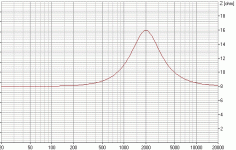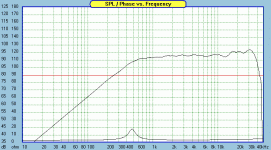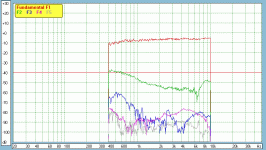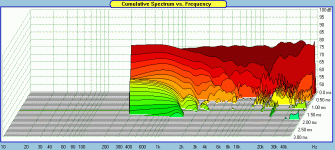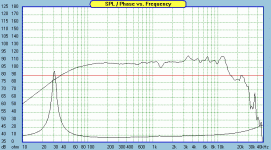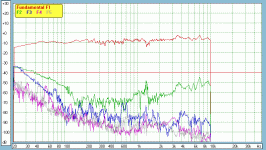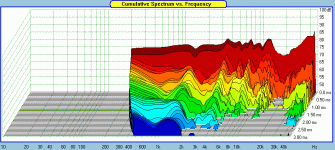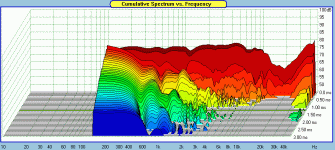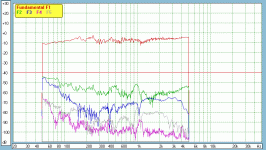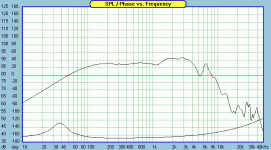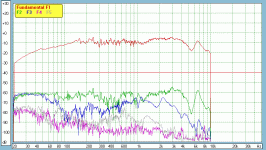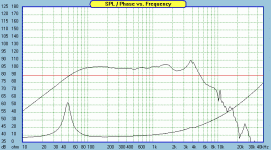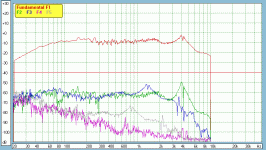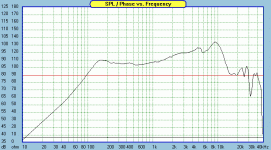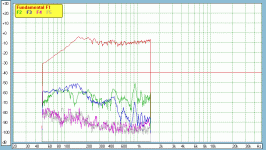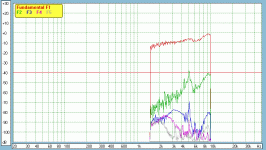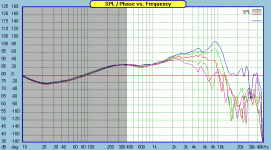No argument that passive xo's can get quite expensive if you choose to go with those big name parts. And if the parts count starts getting out of hand too.
However, to suggest that something like the .4ohms resistance of a single coil in a woofer circuit is going to result in such massive insertion losses that a much more powerful amp is required is a bit of an exaggeration, don't you think?
Perhaps what would be helpful is a comparison of the costing of the actual active components that will be necessary for the OP intended application vs those in a passive xo. For the latter of course, we'll have to wait until a complete simulation is completed before that can be done. I'm not sure if that is also the case for an active set-up.
However, to suggest that something like the .4ohms resistance of a single coil in a woofer circuit is going to result in such massive insertion losses that a much more powerful amp is required is a bit of an exaggeration, don't you think?
Perhaps what would be helpful is a comparison of the costing of the actual active components that will be necessary for the OP intended application vs those in a passive xo. For the latter of course, we'll have to wait until a complete simulation is completed before that can be done. I'm not sure if that is also the case for an active set-up.
I've been looking at the hypex amps for an active system. The look awesome but I wish the availability in the US was a bit easier.
I'm still doing a lot of reading on speaker design. I really liked the combo previously posted and the price wasn't bad. Newtronics Temperance III. I really wish I had a chance to listen first though; anybody had any experience with them directly? The other concern I started having was thinking about a matching center channel as they are dual purpose (more music the movies though) and designing a matching unit.
I'm still doing a lot of reading on speaker design. I really liked the combo previously posted and the price wasn't bad. Newtronics Temperance III. I really wish I had a chance to listen first though; anybody had any experience with them directly? The other concern I started having was thinking about a matching center channel as they are dual purpose (more music the movies though) and designing a matching unit.
mstang, if you seriously have a budget of a $3000 for the front pair, want to re-create or surpass the S8's, if you have the woodworking skills and facilities required and wish to possibly extend the design to front and rear channels, then I think you'd be making a mistake going for something like the Temperance.
I have no doubt that's probably a good sounding speaker, but knowing Paradigm's reputation and the fact that the S8's are their top-of-the-line speakers, I don't think it will come that close to beating it for SQ. (could be wrong of course) Something like the Elsinores (Elsinore Speakers DIY ) would probably come a lot closer (altho I find them to have about 0 aesthetic appeal) but with your budget and starting from scratch, I think you can still do better than that. And I think you could probably do this with either active or passive xo's depending on which way you want to go.
Give me a little time - I am researching some potential drivers that will work within your desired configuration and that should equal or surpass your objectives while still staying within your budget. My thinking is that for $3000, you should actually be able to come up with a set of jaw droppingly-good speakers.
And it's the drivers that are going to make all the difference in terms of achieving your goals. Just take the S8's beryllium tweeter for example. That's one hot tweeter material these days and you can be sure that Paradigm has implemented it well. You should be looking at a *very* good tweeter for your design if you want to be thinking of close to the same results.
I have no doubt that's probably a good sounding speaker, but knowing Paradigm's reputation and the fact that the S8's are their top-of-the-line speakers, I don't think it will come that close to beating it for SQ. (could be wrong of course) Something like the Elsinores (Elsinore Speakers DIY ) would probably come a lot closer (altho I find them to have about 0 aesthetic appeal) but with your budget and starting from scratch, I think you can still do better than that. And I think you could probably do this with either active or passive xo's depending on which way you want to go.
Give me a little time - I am researching some potential drivers that will work within your desired configuration and that should equal or surpass your objectives while still staying within your budget. My thinking is that for $3000, you should actually be able to come up with a set of jaw droppingly-good speakers.
And it's the drivers that are going to make all the difference in terms of achieving your goals. Just take the S8's beryllium tweeter for example. That's one hot tweeter material these days and you can be sure that Paradigm has implemented it well. You should be looking at a *very* good tweeter for your design if you want to be thinking of close to the same results.
However, to suggest that something like the .4ohms resistance of a single coil in a woofer circuit is going to result in such massive insertion losses that a much more powerful amp is required is a bit of an exaggeration, don't you think?
Lets just look at the impedances without DCR of the series inductor in a simple
12dB L-R passive crossover crossing at 2000Hz using 8Ohm drivers:
The textbook series inductor value for the low pass is 1.27mH
Impedance at 1500Hz is 11.96 Ohm, at 1000Hz it is 7.98 Ohm, at 500Hz it is 3.98 Ohm, at 250Hz it is 2 Ohm and at 125Hz it is 1 Ohm.
DC resistance has got to be added to these values.
The impedance of the textbook 4.98microF series capacitor for the high pass is 12.78 Ohm at 2500Hz, 7.98 Ohm at 4000Hz, 3.99 Ohm at 8000Hz and 2 Ohm at 16000Hz.
But you just listed a bunch of impedance numbers that indicate a filter being a filter. That's not insertion loss, it's filtering. Insertion loss is negligible except in speakers with a TON of additive DCR in the crossover. What requires bigger/better amps is high electrical phase angle, which depends on the crossover design.
But you just listed a bunch of impedance numbers that indicate a filter being a filter.
3 octaves below and above crossover point?
Yes, three octaves but the numbers you listed only happen when you put the inductor in a circuit by itself. When you add the 8Ω load that you described, it's a different story. The impedance of the idealized 1.27mH / 4.98uF / 8Ω resistive 2nd order system you suggested is attached, and it corresponds to the filter exactly. No insertion loss until you start adding DCR / ESR.3 octaves below and above crossover point?
Attachments
Last edited:
OK, back to trying to get your speakers built. (Warning: long posts ahead)
First, understand that instead of going active, you can actually get some help from the experts in the on-line community to model your design and produce a specific passive xo for your intended application (see this current thread for eg http://www.diyaudio.com/forums/multi-way/230003-design-me-crossover-ill-build.html ). If the xo is designed properly, you can still make small mid and/or tweeter level adjustments by ear or with free on-line test tones and a cheap SPL meter once the speakers are in your own environment.
Note that one little thing that might help you succeed at this is locating a fellow diy’er in your area with measurement gear that would be willing to measure your speakers once the cabinets with drivers are built but without any xo’s designed yet. This will add an extra degree of accuracy to your project, although the simulation process is actually quite good and can produce outstanding results.
To increase the probability of achieving this, I would suggest expanding the number of people you have access to by also starting a similar thread on a second forum, Tech Talk Forum
And full disclosure, I’ve been at this for a number of years but I’m still far from being an expert. I can help you along the way but I’ll still be relying as well on some help and confirmation from others.
OK, I wanted to answer the last question from your original post first.
Re the RTi6’s, just pick a suitable 2-way project with an F3 in the 50Hz range from any of the following sites and that meets the budget, pretty much all of them have very good SQ:
Perhaps the Overnight Sensations, or the Hitmakers? https://sites.google.com/site/undefinition/diy
Veepers would be an excellent choice. Build Gallery
This one is also highly praised. Continuum, Pr
Zaph|Audio
Btw, if you haven’t found Zaph’s site yet, bookmark it and start reading, especially if you want to shed some light on how to select drivers when you’re unable to hear them first.
Cheers
jR
First, understand that instead of going active, you can actually get some help from the experts in the on-line community to model your design and produce a specific passive xo for your intended application (see this current thread for eg http://www.diyaudio.com/forums/multi-way/230003-design-me-crossover-ill-build.html ). If the xo is designed properly, you can still make small mid and/or tweeter level adjustments by ear or with free on-line test tones and a cheap SPL meter once the speakers are in your own environment.
Note that one little thing that might help you succeed at this is locating a fellow diy’er in your area with measurement gear that would be willing to measure your speakers once the cabinets with drivers are built but without any xo’s designed yet. This will add an extra degree of accuracy to your project, although the simulation process is actually quite good and can produce outstanding results.
To increase the probability of achieving this, I would suggest expanding the number of people you have access to by also starting a similar thread on a second forum, Tech Talk Forum
And full disclosure, I’ve been at this for a number of years but I’m still far from being an expert. I can help you along the way but I’ll still be relying as well on some help and confirmation from others.
OK, I wanted to answer the last question from your original post first.
Re the RTi6’s, just pick a suitable 2-way project with an F3 in the 50Hz range from any of the following sites and that meets the budget, pretty much all of them have very good SQ:
Perhaps the Overnight Sensations, or the Hitmakers? https://sites.google.com/site/undefinition/diy
Veepers would be an excellent choice. Build Gallery
This one is also highly praised. Continuum, Pr
Zaph|Audio
Btw, if you haven’t found Zaph’s site yet, bookmark it and start reading, especially if you want to shed some light on how to select drivers when you’re unable to hear them first.
Cheers
jR
Driver Selection
Breaking down the salient features of the Paradigm S8 (v.3):
- 48.5” x 8.5” x 20.5” external dimensions
- ¾” MDF slightly curved sides and curved top construction
- 47” x 7” x 19” internal dimensions
- total internal volume = about 100L or 3.53 ft^3 (some volume loss due to the curved sides)
- F3 = 39Hz with 4 x 7” drivers, 2 x ported alignment
- Beryllium tweeter, 7” midranges
- drivers “decoupled” from the baffle
- XO points of 230HZ and 2000Hz
- total harmonic distortion levels start showing their peaks at about -45dB across the FR at 90dB SPL (Signature S8 - Welcome to the New Official Paradigm® Website. from SoundStage review, measurements at bottom of page) although to be fair, it looks like that was from the S8 v.2
So, essentially you are trying to build a reference level TMWWWW with about the same dimensions and FR for $3000. Probably the 2 most important things you need are a tweeter to match the quality of the beryllium tweeter and woofers that are happy to operate in a relatively small volume, ie F3 = < 40Hz in 15 to 18L each (volume calculations to follow).
Driver selections should also work at center and rear speaker locations – so do you have any CC space limitations to take note of?
Note that the tweeter height is fairly high in this design – about 45” to 48” if you include the feet. Your ears should be at the same level as the tweeter (especially if you go with a ribbon tweeter) or else the speaker will need to be angled slightly downwards. What’s your listening height?
Also, BSC (baffle step compensation) needs to be taken into account when matching all the drivers. This is affected by speaker placement relative to the walls and the size of your room. What is your room size and what will the distances be from the back wall, the side wall and the floor to the front of the speakers?
I’m thinking $1800 to $2000 for the drivers with about $1000 to $1200 left over for the xo’s, cabinets and misc things like binding posts, wiring, internal stuffing, etc , etc.
Again, ain’t gonna call myself an expert and I haven’t heard everything out there so the following are suggestions based on 3rd party opinions, reviews, usage by certain companies, etc. and on available measurement data (the one I do own and love is the ScanSpeak mid I’ve listed below, although in the 8ohm version – fantastic driver). Certainly others will have their own favorites. Mostly I’m looking for drivers with 3rd and 5th order HD that is 60dB below the fundamental in the usable passband, 70dB down is even better, and that will all work well together. If you don’t know what any of this means or are not familiar with the types of graphs I’m using below, just ask. Some of the jargon is also for the benefit of anyone else reading.
I looked at a lot of driver combinations. These are what I would use in your situation. All of them will blow you away.
To avoid information overload, I’m just listing my top 2 choices, better ones first.
Tweeters:
1 Raal 70-10D - $390 ea.
The Madisound Speaker Store
SPL = 92dB
xo LR4 > 2800Hz
Can’t say I like the foam, but Raal’s tweeters are considered by many to be among the best out there.
2 ScanSpeak Illuminator 6600 AirCirc - $213 ea. The Madisound Speaker Store
SPL = 92.5dB
Fs = 520Hz
xo LR2 > 2000Hz
3rd, 4th and 5th HD stay pretty much 70dB below the fundamental between 1000 – 10,000Hz – fantastic.
A very quiet CSD shows best usage is above 2000Hz.
Breaking down the salient features of the Paradigm S8 (v.3):
- 48.5” x 8.5” x 20.5” external dimensions
- ¾” MDF slightly curved sides and curved top construction
- 47” x 7” x 19” internal dimensions
- total internal volume = about 100L or 3.53 ft^3 (some volume loss due to the curved sides)
- F3 = 39Hz with 4 x 7” drivers, 2 x ported alignment
- Beryllium tweeter, 7” midranges
- drivers “decoupled” from the baffle
- XO points of 230HZ and 2000Hz
- total harmonic distortion levels start showing their peaks at about -45dB across the FR at 90dB SPL (Signature S8 - Welcome to the New Official Paradigm® Website. from SoundStage review, measurements at bottom of page) although to be fair, it looks like that was from the S8 v.2
So, essentially you are trying to build a reference level TMWWWW with about the same dimensions and FR for $3000. Probably the 2 most important things you need are a tweeter to match the quality of the beryllium tweeter and woofers that are happy to operate in a relatively small volume, ie F3 = < 40Hz in 15 to 18L each (volume calculations to follow).
Driver selections should also work at center and rear speaker locations – so do you have any CC space limitations to take note of?
Note that the tweeter height is fairly high in this design – about 45” to 48” if you include the feet. Your ears should be at the same level as the tweeter (especially if you go with a ribbon tweeter) or else the speaker will need to be angled slightly downwards. What’s your listening height?
Also, BSC (baffle step compensation) needs to be taken into account when matching all the drivers. This is affected by speaker placement relative to the walls and the size of your room. What is your room size and what will the distances be from the back wall, the side wall and the floor to the front of the speakers?
I’m thinking $1800 to $2000 for the drivers with about $1000 to $1200 left over for the xo’s, cabinets and misc things like binding posts, wiring, internal stuffing, etc , etc.
Again, ain’t gonna call myself an expert and I haven’t heard everything out there so the following are suggestions based on 3rd party opinions, reviews, usage by certain companies, etc. and on available measurement data (the one I do own and love is the ScanSpeak mid I’ve listed below, although in the 8ohm version – fantastic driver). Certainly others will have their own favorites. Mostly I’m looking for drivers with 3rd and 5th order HD that is 60dB below the fundamental in the usable passband, 70dB down is even better, and that will all work well together. If you don’t know what any of this means or are not familiar with the types of graphs I’m using below, just ask. Some of the jargon is also for the benefit of anyone else reading.
I looked at a lot of driver combinations. These are what I would use in your situation. All of them will blow you away.
To avoid information overload, I’m just listing my top 2 choices, better ones first.
Tweeters:
1 Raal 70-10D - $390 ea.
The Madisound Speaker Store
SPL = 92dB
xo LR4 > 2800Hz
Can’t say I like the foam, but Raal’s tweeters are considered by many to be among the best out there.
2 ScanSpeak Illuminator 6600 AirCirc - $213 ea. The Madisound Speaker Store
SPL = 92.5dB
Fs = 520Hz
xo LR2 > 2000Hz
An externally hosted image should be here but it was not working when we last tested it.
3rd, 4th and 5th HD stay pretty much 70dB below the fundamental between 1000 – 10,000Hz – fantastic.
A very quiet CSD shows best usage is above 2000Hz.
Attachments
Last edited:
I disagree. Somewhere around the midrange axis would be a reasonable design axis, but regardless of that the tweeter is only going to be around 3° above ear level at any reasonable listening distance (you don't listen to a tower like this from 4' away). If your speaker can't put out a consistent 6° vertical pattern, you didn't do it right.Note that the tweeter height is fairly high in this design – about 45” to 48” if you include the feet. Your ears should be at the same level as the tweeter (especially if you go with a ribbon tweeter) or else the speaker will need to be angled slightly downwards. What’s your listening height?
Mids:
1. SB Satori MW16P - $287 ea.
The Madisound Speaker Store
SPL = 87.5dB
Usable Passband = 300 – 2000Hz
Volume for Qtc of .703 = 10L
This may have one of the lowest HD profiles of any coned driver out there. 3rd, 4th and 5th HD are again pretty much 70dB down between 300 – 10,000Hz. Very, very clean.
A small hiccup in the FR at about 1200Hz but that’s probably easily forgiven.
Off-axis response starts to deviate at about 1500Hz and energy storage starts to increase above 3000Hz so don’t cross above 2000Hz.
2. ScanSpeak Revelator 15W4531K00-4 – $220 ea.
The Madisound Speaker Store
SPL = 90dB
Usable Passband = 300 – 2800’ish Hz
Volume for Qtc of .560 = 3L
Graphs are for this driver’s 8ohm brother but should be fairly close. Not quite as clean as the Satori but lots of magic here nevertheless.
Just a little contouring work required above 1000Hz.
First 3 graphs are the Satori. The next 2 are the SanSpeak.
1. SB Satori MW16P - $287 ea.
The Madisound Speaker Store
SPL = 87.5dB
Usable Passband = 300 – 2000Hz
Volume for Qtc of .703 = 10L
This may have one of the lowest HD profiles of any coned driver out there. 3rd, 4th and 5th HD are again pretty much 70dB down between 300 – 10,000Hz. Very, very clean.
A small hiccup in the FR at about 1200Hz but that’s probably easily forgiven.
Off-axis response starts to deviate at about 1500Hz and energy storage starts to increase above 3000Hz so don’t cross above 2000Hz.
2. ScanSpeak Revelator 15W4531K00-4 – $220 ea.
The Madisound Speaker Store
SPL = 90dB
Usable Passband = 300 – 2800’ish Hz
Volume for Qtc of .560 = 3L
Graphs are for this driver’s 8ohm brother but should be fairly close. Not quite as clean as the Satori but lots of magic here nevertheless.
Just a little contouring work required above 1000Hz.
First 3 graphs are the Satori. The next 2 are the SanSpeak.
Attachments
Woofers:
Making some quick calculations re cabinet volumes:
- you may want to go with thicker wall construction. 1” thick walls would mean 90L internal volume to start instead of 100L
- tweeter and mid enclosure volume might vary between 4 to 12L depending on mid selection
- a healthy amount of woofer cab bracing + port volumes + driver volumes + xo (if passive) = maybe 15-20L
which leaves anywhere from about 60 to 70L for the 4 woofers or 15 to 18L per woofer. You can easily alter some of the cabinet dimensions to optimize internal volumes.
F3 calculations were done with Unibox FRD Consortium. LF xo is expected to be in the 300 – 500Hz range to more closely match with the baffle step frequency.
1. 7” Usher 8945A - $130 ea.
Usher 8945A 7" Carbon Fiber/Paper Woofer 296-600
F3 = 39Hz in 18L
SPL = 87dB
HD profile is virtually identical to the well known and more expensive Seas W18EX001 magnesium driver. In the LF’s, it’s better than the venerable SanSpeak Revelator 18W8531G: 3rd order stays 60dB down 80 -800Hz and 50dB down below 80Hz. Very nice.
2. 6.5” Exodus Anarchy - $90 ea.
DIYCable.com : Intro » Home » Exodus Anarchy
F3 = 31Hz in 15L
SPL = 85dB
This is a remarkable 6.5” driver with huge xmax, almost subwoofer like lows in a small box and all HD down 50dB below 1500Hz. Magnet is huge and ports need to be a little long which somewhat negates the low box volume. Still, 5 of these around the room in a home theater plus 2 subwoofers turns it into essentially a 5.7 system. That should produce some fantastically accurate bass at the seating positions and probably with way more headroom that you could possibly need with 4 of them each at front L and R!!
One caveat: I’ve heard that these are no longer being made. They are just selling off their present stock. If this is true, it would kind of necessitate that you buy enough to complete your home theater system all at once if this is the way you wan to go.
First 2 are the Usher. Next 2 are the Anarchy.
Making some quick calculations re cabinet volumes:
- you may want to go with thicker wall construction. 1” thick walls would mean 90L internal volume to start instead of 100L
- tweeter and mid enclosure volume might vary between 4 to 12L depending on mid selection
- a healthy amount of woofer cab bracing + port volumes + driver volumes + xo (if passive) = maybe 15-20L
which leaves anywhere from about 60 to 70L for the 4 woofers or 15 to 18L per woofer. You can easily alter some of the cabinet dimensions to optimize internal volumes.
F3 calculations were done with Unibox FRD Consortium. LF xo is expected to be in the 300 – 500Hz range to more closely match with the baffle step frequency.
1. 7” Usher 8945A - $130 ea.
Usher 8945A 7" Carbon Fiber/Paper Woofer 296-600
F3 = 39Hz in 18L
SPL = 87dB
HD profile is virtually identical to the well known and more expensive Seas W18EX001 magnesium driver. In the LF’s, it’s better than the venerable SanSpeak Revelator 18W8531G: 3rd order stays 60dB down 80 -800Hz and 50dB down below 80Hz. Very nice.
2. 6.5” Exodus Anarchy - $90 ea.
DIYCable.com : Intro » Home » Exodus Anarchy
F3 = 31Hz in 15L
SPL = 85dB
This is a remarkable 6.5” driver with huge xmax, almost subwoofer like lows in a small box and all HD down 50dB below 1500Hz. Magnet is huge and ports need to be a little long which somewhat negates the low box volume. Still, 5 of these around the room in a home theater plus 2 subwoofers turns it into essentially a 5.7 system. That should produce some fantastically accurate bass at the seating positions and probably with way more headroom that you could possibly need with 4 of them each at front L and R!!
One caveat: I’ve heard that these are no longer being made. They are just selling off their present stock. If this is true, it would kind of necessitate that you buy enough to complete your home theater system all at once if this is the way you wan to go.
First 2 are the Usher. Next 2 are the Anarchy.
Attachments
Putting them together:
System 1.1:
Raal - 2 x $389 = $780
SS 15W - 2 x $220 = $440
Usher - 8 x $130 = $1040
total=$2260
System 1.2:
Raal - 2 x $389 = $780
SS 15W - 2 x $220 = $440
Usher - 6 x $130 = $780
total=$2000
System 2.1:
Raal - 2 x $389 = $ 780
SS 15W - 2 x $220 = $ 440
Anarchy - 8 x $90 = $ 720
total = $1940
System 2.2:
Raal - 2 x $389 = $ 780
SS 15W - 2 x $220 = $ 440
Anarchy - 6 x $90 = $ 540
total = $1760
System 3.1:
SS 6600 - 2 x $213 = $ 426
Satori - 2 x $287 = $ 574
Usher - 8 x $130 = $1040
total = $2040
System 3.2:
SS 6600 - 2 x $213 = $ 426
Satori - 2 x $287 = $ 574
Usher - 6 x $130 = $780
total = $1780
System 4.1:
SS 6600 - 2 x $213 = $ 426
Satori - 2 x $287 = $ 574
Anarchy - 8 x $90 = $ 720
total = $1720
System 4.2:
SS 6600 - 2 x $213 = $ 426
Satori - 2 x $287 = $ 574
Anarchy - 6 x $90 = $ 540
total = $1540
System 5.1:
SS 6600 - 2 x $213 = $ 426
SS 15W - 2 x $220 = $ 440
Usher - 8 x $130 = $1040
total = $1906
System 5.2:
SS 6600 - 2 x $213 = $ 426
SS 15W - 2 x $220 = $ 440
Usher - 6 x $130 = $ 780
total = $1646
System 6.1:
SS 6600 - 2 x $213 = $ 426
SS 15W - 2 x $220 = $ 440
Anarchy - 8 x $90 = $ 720
total = $1586
System 6.2:
SS 6600 - 2 x $213 = $ 426
SS 15W - 2 x $220 = $ 440
Anarchy - 6 x $90 = $ 540
total = $1406
Notice that to save money but to keep SQ high, I’ve deviated from your original goal of a TMWWWW and listed a 2nd option for each system with just 3 woofers instead of 4. Cabinet size will have to be adjusted a little (and/or you could add more bracing and thicker walls) but I don’t believe you’ll notice any difference with just the 3. I checked and your Rotels will be happy with a 4 ohm load.
Also notice that the Satori needs a lower xo point (about 2000Hz) so it has to be matched with the 6600 tweeter.
On the other hand, the Raal needs a higher xo point (up near 3000Hz), so it must be matched with the SS15W mid, although that’s pushing the off-axis response of the SS a little bit.
What I’d really like to do is combine that Raal with something as good as the Satori, but my suggestion for that would deviate a little more from the look of the Paradigms. The mid I really want to use with it is this one:
B&G Neo10 - $200 ea.
Bohlender Graebener Neo10 Planar Transducer 264-715
SPL = 92dB
Usable Passband = 300Hz - 6000Hz
Internal volume = 2 - 3L
This is an outstanding Planar - 3rd, 4th and 5th HD are again pretty much 70dB down between 600 – 10,000Hz. Don’t have the CSD but I expect the energy storage to be better than a coned driver. More important, it can be easily crossed at 3000 or 4000Hz to the Raal without concerns about the off-axis response.
But it does mean a different look than the S8’s and there could be a potential problem when using it in a center channel if there are height restrictions where it needs to go.
It is also unfortunately a bit more difficult to implement because it can’t be modeled as easily as the others. Not impossible in your situation but this one would definitely benefit from measurements before the xo design. Still my choice would be one of these 2 systems over the others for maximum bang for your buck:
System 7.1:
Raal - 2 x $389 = $ 780
Neo 10 - 2 x $200 = $ 400
Usher - 6 x $130 = $ 780
total = $1960
System 7.2:
Raal - 2 x $389 = $ 780
Neo 10 - 2 x $200 = $ 400
Anaarchy - 6 x $90 = $540
total = $1720
OK, that’s probably a lot of info to take in.
Read, digest, ask more questions.
Watch to see how badly I get flamed for some of my suggestions.
Graphs for the Neo10:
System 1.1:
Raal - 2 x $389 = $780
SS 15W - 2 x $220 = $440
Usher - 8 x $130 = $1040
total=$2260
System 1.2:
Raal - 2 x $389 = $780
SS 15W - 2 x $220 = $440
Usher - 6 x $130 = $780
total=$2000
System 2.1:
Raal - 2 x $389 = $ 780
SS 15W - 2 x $220 = $ 440
Anarchy - 8 x $90 = $ 720
total = $1940
System 2.2:
Raal - 2 x $389 = $ 780
SS 15W - 2 x $220 = $ 440
Anarchy - 6 x $90 = $ 540
total = $1760
System 3.1:
SS 6600 - 2 x $213 = $ 426
Satori - 2 x $287 = $ 574
Usher - 8 x $130 = $1040
total = $2040
System 3.2:
SS 6600 - 2 x $213 = $ 426
Satori - 2 x $287 = $ 574
Usher - 6 x $130 = $780
total = $1780
System 4.1:
SS 6600 - 2 x $213 = $ 426
Satori - 2 x $287 = $ 574
Anarchy - 8 x $90 = $ 720
total = $1720
System 4.2:
SS 6600 - 2 x $213 = $ 426
Satori - 2 x $287 = $ 574
Anarchy - 6 x $90 = $ 540
total = $1540
System 5.1:
SS 6600 - 2 x $213 = $ 426
SS 15W - 2 x $220 = $ 440
Usher - 8 x $130 = $1040
total = $1906
System 5.2:
SS 6600 - 2 x $213 = $ 426
SS 15W - 2 x $220 = $ 440
Usher - 6 x $130 = $ 780
total = $1646
System 6.1:
SS 6600 - 2 x $213 = $ 426
SS 15W - 2 x $220 = $ 440
Anarchy - 8 x $90 = $ 720
total = $1586
System 6.2:
SS 6600 - 2 x $213 = $ 426
SS 15W - 2 x $220 = $ 440
Anarchy - 6 x $90 = $ 540
total = $1406
Notice that to save money but to keep SQ high, I’ve deviated from your original goal of a TMWWWW and listed a 2nd option for each system with just 3 woofers instead of 4. Cabinet size will have to be adjusted a little (and/or you could add more bracing and thicker walls) but I don’t believe you’ll notice any difference with just the 3. I checked and your Rotels will be happy with a 4 ohm load.
Also notice that the Satori needs a lower xo point (about 2000Hz) so it has to be matched with the 6600 tweeter.
On the other hand, the Raal needs a higher xo point (up near 3000Hz), so it must be matched with the SS15W mid, although that’s pushing the off-axis response of the SS a little bit.
What I’d really like to do is combine that Raal with something as good as the Satori, but my suggestion for that would deviate a little more from the look of the Paradigms. The mid I really want to use with it is this one:
B&G Neo10 - $200 ea.
Bohlender Graebener Neo10 Planar Transducer 264-715
SPL = 92dB
Usable Passband = 300Hz - 6000Hz
Internal volume = 2 - 3L
This is an outstanding Planar - 3rd, 4th and 5th HD are again pretty much 70dB down between 600 – 10,000Hz. Don’t have the CSD but I expect the energy storage to be better than a coned driver. More important, it can be easily crossed at 3000 or 4000Hz to the Raal without concerns about the off-axis response.
But it does mean a different look than the S8’s and there could be a potential problem when using it in a center channel if there are height restrictions where it needs to go.
It is also unfortunately a bit more difficult to implement because it can’t be modeled as easily as the others. Not impossible in your situation but this one would definitely benefit from measurements before the xo design. Still my choice would be one of these 2 systems over the others for maximum bang for your buck:
System 7.1:
Raal - 2 x $389 = $ 780
Neo 10 - 2 x $200 = $ 400
Usher - 6 x $130 = $ 780
total = $1960
System 7.2:
Raal - 2 x $389 = $ 780
Neo 10 - 2 x $200 = $ 400
Anaarchy - 6 x $90 = $540
total = $1720
OK, that’s probably a lot of info to take in.
Read, digest, ask more questions.
Watch to see how badly I get flamed for some of my suggestions.
Graphs for the Neo10:
I disagree. Somewhere around the midrange axis would be a reasonable design axis, but regardless of that the tweeter is only going to be around 3° above ear level at any reasonable listening distance (you don't listen to a tower like this from 4' away). If your speaker can't put out a consistent 6° vertical pattern, you didn't do it right.
Yea, fair enough. I'm just used to the rule of thumb of listening on-axis to the tweeter and Paradigm actually mentions this specific fact in their info for the speaker - try to be on-axis or tilt the speaker slightly downward.
Thanks for the details! I'm going to have to read through this in detail and work to understand it. I'm also getting married next week so might be quiet for a bit.
How do planar mids respond off axis? I've never heard them. It wouldn't be the worst thing to deviate if they sound that much better but if about the same looks are always interesting. 3 Woofers could be sufficient; the Sig s6's didn't have enough down low but only had 1 driver. My current RTi12's have 3 and those more then enough to make the room dance. I just want better SQ!
How do planar mids respond off axis? I've never heard them. It wouldn't be the worst thing to deviate if they sound that much better but if about the same looks are always interesting. 3 Woofers could be sufficient; the Sig s6's didn't have enough down low but only had 1 driver. My current RTi12's have 3 and those more then enough to make the room dance. I just want better SQ!
Last edited:
Thanks for the details! I'm going to have to read through this in detail and work to understand it. I'm also getting married next week so might be quiet for a bit.
Yea, I'll say! Best of luck.
How do planar mids respond off axis? I've never heard them. It wouldn't be the worst thing to deviate if they sound that much better but if about the same looks are always interesting. 3 Woofers could be sufficient; the Sig s6's didn't have enough down low but only had 1 driver. My current RTi12's have 3 and those more then enough to make the room dance. I just want better SQ!
Asking how planar mids respond off-axis is the wrong question. Asking how *these* planar mids respond off-axis is a much better one, especially since I forgot to post that graph (see below). Red is 30 degrees off-axis and you can see that it hardly starts dropping from the blue one until 6000Hz. That's better than some tweeters.
I think one of the hardest parts of diy audio when you're just starting out and don't know how to read or understand all the technical stuff is to just have faith in those of us that do have the experience. Trust me, all of the choices I've listed will have better SQ than almost anything you have probably listened to, certainly in your home.
I had no idea what people meant when they were talking about a really quiet sound floor or a kind of dead, quiet sonic darkness out of which voices, instruments and images emerge and are surrounded by, and of really seeing the recorded acoustic environment and having the listening experience be like actually being there until I built my first pair of speakers using one of the ScanSpeak 15W drivers. I couldn't wipe the smile off my face for weeks.
Especially with studio vocals, I can literally picture the acoustically dead recording booth that the person is sitting in and easily identify the reverb and/or echo that's applied. Separation between everything is just so fantastic. And this is what you get from well built,low distortion low energy storage drivers like I've listed for you. The ScanSpeak isn't even the best of the lot I've listed. Of course you need a properly implemented xo too, passive or active, and a very well built cabinet as well. Acoustic treatment in the room also helps.
You're going to have to take a little time when you can find it and read through all the info. Don't make hasty decisions. Get a consensus here for your choices. In the end, I think you'll be well pleased.
One amendment to my previous posts. My brain was getting fried there at the end and I forgot that unfortunately Systems 3.1 and 3.2 are a no go - SPL's of the Satori mid are too low to match with those of the combined Usher woofers. Sorry about that.
Cheers
Attachments
Yea, I'll say! Best of luck.
Asking how planar mids respond off-axis is the wrong question. Asking how *these* planar mids respond off-axis is a much better one, especially since I forgot to post that graph (see below). Red is 30 degrees off-axis and you can see that it hardly starts dropping from the blue one until 6000Hz. That's better than some tweeters.
I think one of the hardest parts of diy audio when you're just starting out and don't know how to read or understand all the technical stuff is to just have faith in those of us that do have the experience. Trust me, all of the choices I've listed will have better SQ than almost anything you have probably listened to, certainly in your home.
I had no idea what people meant when they were talking about a really quiet sound floor or a kind of dead, quiet sonic darkness out of which voices, instruments and images emerge and are surrounded by, and of really seeing the recorded acoustic environment and having the listening experience be like actually being there until I built my first pair of speakers using one of the ScanSpeak 15W drivers. I couldn't wipe the smile off my face for weeks.
Especially with studio vocals, I can literally picture the acoustically dead recording booth that the person is sitting in and easily identify the reverb and/or echo that's applied. Separation between everything is just so fantastic. And this is what you get from well built,low distortion low energy storage drivers like I've listed for you. The ScanSpeak isn't even the best of the lot I've listed. Of course you need a properly implemented xo too, passive or active, and a very well built cabinet as well. Acoustic treatment in the room also helps.
You're going to have to take a little time when you can find it and read through all the info. Don't make hasty decisions. Get a consensus here for your choices. In the end, I think you'll be well pleased.
One amendment to my previous posts. My brain was getting fried there at the end and I forgot that unfortunately Systems 3.1 and 3.2 are a no go - SPL's of the Satori mid are too low to match with those of the combined Usher woofers. Sorry about that.
Cheers
I like the 6.1 combination as I want to stay away from Ribon's/planars for now and those Anarchy drivers look awesome! I like the thought of 4 woofers as I have a huge area. A few questions though, the range is shown as a 30hz bottom end. I assume it plays lower but falls off quickly. The sensitivity is also quite different between the drivers but I understand SPL also increases by 3db per driver so 85->88->91->93, does that sound correct? Any reason I should consider a transmission line design for the enclosure? I like the look of a curved box but I foresee challenges in building this. A possible option would be for me to get access to a 2D CNC machine for wood. i assume I could create a structure out of MDF and laminate the layers together. The same concept as this but with MDF. This would also allow me to integrate the front baffle and build a curved baffle if needed for baffle defraction. It would add $175 to the project but may be worth it. http://www.soundbysinger.com/UserFiles/image/Magico M5 Full.jpg
System 6.1:
SS 6600 - 2 x $213 = $ 426
SS 15W - 2 x $220 = $ 440
Anarchy - 8 x $90 = $ 720
total = $1586
As a side note why are they clearing the woofers?
Thanks again for all the work you put in!
- Status
- This old topic is closed. If you want to reopen this topic, contact a moderator using the "Report Post" button.
- Home
- Loudspeakers
- Multi-Way
- Noob needing advice - Driver cost vs Sound Quality Estimates
